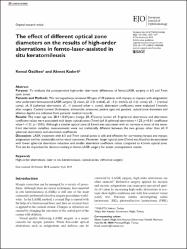The effect of different optical zone diameters on the results of high-order aberrations in femto-laser-assisted in situ keratomileusis
Özet
Purpose: To evaluate the postoperative high-order aberration differences of femto-LASIK surgery in 6.5 and 7 mm optic zones. Patients and Methods: We retrospectively reviewed 80 eyes of 40 patients with myopia or myopia with astigmatism who underwent femtosecond LASIK surgery. Q values, z3, 3 (h. trefoil), z3, -3 (v. trefoil), z3, 1 (h. coma), z3, -1 (vertical coma), z4, 0 (spherical aberration), z5, -1 (second other v. coma), aberration coefficients were evaluated 3 months after surgery. Central corneal thicknesses, intraocular pressures, patient ages and genders, optical zone diameters and ablation depths are collected from patients' medical records. Results: The mean age was 28.4 +/- 0.69 years (range, 20-47 years). Lower z4, 0 spherical aberrations and aberration coefficient values were associated with larger optical zones (7 mm) (z4, 0 spherical aberrations = 1.25, p = 0.01; coefficient value = -1.21, p < 0.01). Although a smaller optical zone (6.5 mm) was associated with an increase in most of the wave-front aberration variables, measurements were not statistically different between the two groups other than z4, 0 spherical aberrations and aberration coefficients. Discussion: LASIK treatment with 6.5 and 7 mm optical zones is safe and effective for correcting myopia and myopic astigmatism and has statistically similar visual outcomes. Moreover, larger optical zone (7 mm) was found to be associated with lower spherical aberration induction and smaller aberration coefficient values compared to 6.5 mm optical zone. This can be important for decision-making in femto-LASIK surgery for better postoperative results.


















